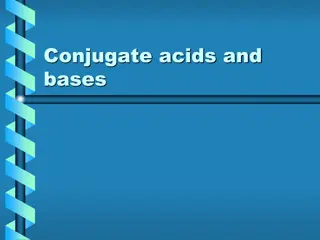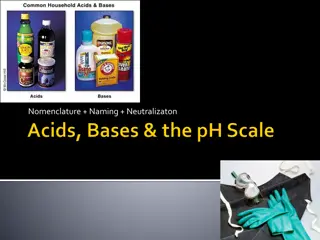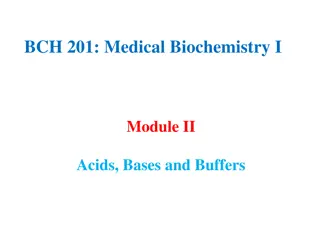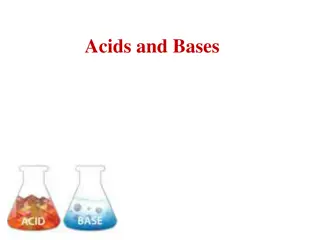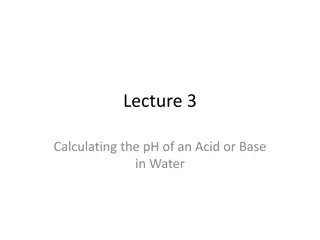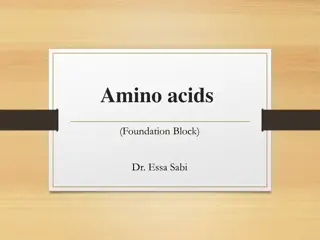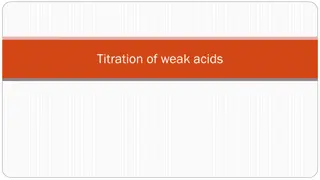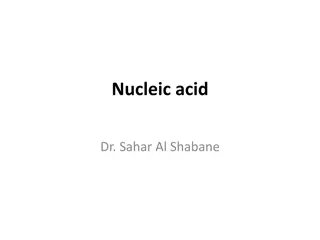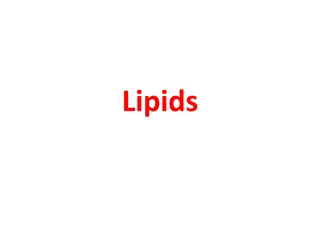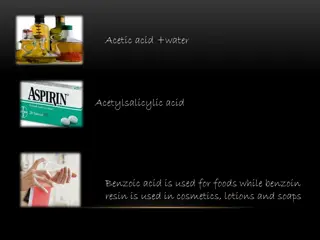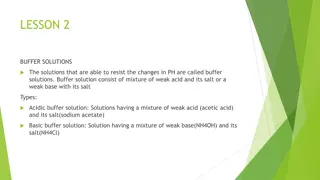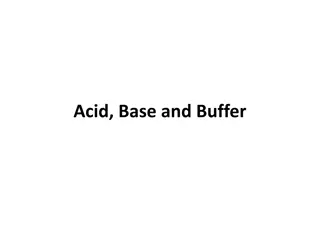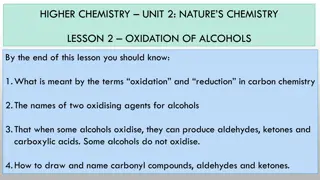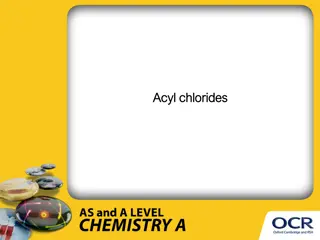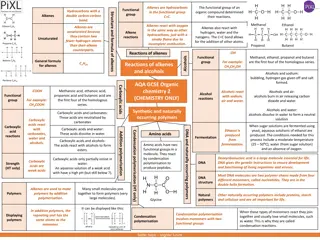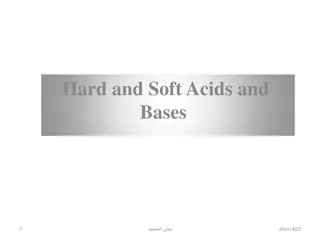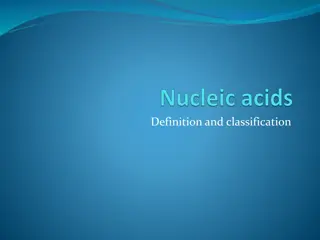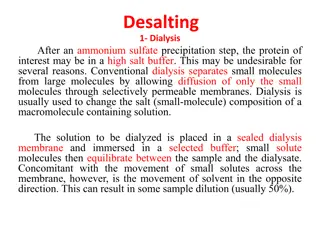Understanding Polyprotic Acids and Salts in Chemistry
Exploring the concept of polyprotic acids, particularly focusing on sulfuric acid as a unique example with its dual dissociation steps. The discussion delves into the equilibrium concentrations of ions in solution, calculating pH values for different acid concentrations, and understanding the significance of the first dissociation step in polyprotic acids. Additionally, we examine the role of salts in maintaining pH balance, highlighting the characteristics of conjugate acids and bases. Through examples and explanations, this content provides a comprehensive overview of these key topics in chemistry.
Download Presentation

Please find below an Image/Link to download the presentation.
The content on the website is provided AS IS for your information and personal use only. It may not be sold, licensed, or shared on other websites without obtaining consent from the author. Download presentation by click this link. If you encounter any issues during the download, it is possible that the publisher has removed the file from their server.
E N D
Presentation Transcript
Homework Complete the AP practice test at the end of Chapter 14 Acid and Bases It is in between page 598-599
Polyprotic Acids A polyprotic acid has more than one ionizable proton (H+). e.g. H2SO4, H2CO3, H3AsO4 Each successive Kavalue get smaller (Ka1 > Ka2> Ka3). Therefore, the first dissociation step makes the most significant contribution to the equilibrium concentration of [H+].
Sulfuric acid is unique in being a strong acid in its first dissociation step and a weak acid in its second step.
LeChtelier For 1.0 M or larger solutions of sulfuric acid, the large concentration of H3O+ from the first dissociation step represses the second step, which can be neglected as a contributor of H3O+ions. For dilute solutions of sulfuric acid, the second step does make a significant contribution, ICE tables must be used to obtain the total H3O+concentration.
Problem Calculate the pH of .50 M H2SO4 H2SO4 HSO4-+ H+ HSO4- SO42-+ H+ The main difference from sulfuric acid from other problems will be the first step. 0.50 M H2SO4means .50 M H+and .5 M HSO4-is formed. Now to the second dissociation Kais very large Ka= 1.2x10-2
Cont. I .50 M .50 M C -x +x +x E .50 x x Ka= x(.5+x) / (.5-x) = 1.2 x10-2 x = .011462 [HSO4-]= .49 M [SO42-]= .011 M [H+] = .51 M pH = .29 HSO4- SO42-+ H+ .50 + x
Problem Calculate the pH, [H+], [HSO4-], [SO42-] of .20 M H2SO4 Calculate the pH of a 5.0 M H3PO4solution and the equilibrium concentrations of the species H3PO4, H2PO4-, HPO42-, and PO43-. Ka1= 7.5 x 10-3 Ka2= 6.2 x 10-8 Ka3= 4.8 x 10-13
Salts and pH Salts are made of conjugate acids and bases. The conjugate acid/bases of strong acids or base will be neutral, excluding H2SO4. To be a strong acid or base, the conjugate base or acid must have no affinity for protons or hydroxide. That is to say it won t run the reverse reaction under any conditions.
Salts of weak acids and bases Conjugate bases/acids of weak acids and bases will run the reverse reactions. Conjugate base of weak acids are weak bases HF H++ F- F-+ H2O HF + OH- Conjugate acids of weak bases are weak acids NH3 NH4++ OH- NH4+ NH3+ H+
pH of salt Salts are made by joining the conjugate acids and bases Would potassium chlorite be acidic or basic? KClO2 K++ ClO2- Potassium is neutral (KOH = strong base), chlorite is basic (HClO2= weak acid) Therefore it is basic
Question Are these salts acidic or basic? NH4Cl NaCH3COO Ca(NO3)2
What about salts of a weak acid and a weak bases If you have NH4F You have to look at the Kavalue of NH4+ and compare it to the Kbvalue of F-to see which weak acid/base is stronger. The larger the K value the stronger the acid/base. 14
Ka and Kb The Ka and Kb of a weak acid and its conjugate base or a weak base and its conjugate acid are related and easily calculated from one another For a weak acid and its conjugate base or a weak base and its conjugate acid only Ka x Kb = Kw
Problem Calculate the Ka of NH4Cl solution. The Kb value for NH3 is 1.8 x 10-5. Calculate the Kb of NaF solution. The Ka value for HF is 7.2 x 10-4.
Hydrated metal ions Charged metals ions also produce an acidic solution. The metal itself does not act as a Br nsted- Lowry acid, but instead forms a hydrate that acts as a Br nsted-Lowry acid. Typically the higher the charge on the metal ion, stronger the acidity of the hydrated ion. Cu2+ + 5 H2O Cu(H2O)52+ Cu(H2O)52+ CuOH(H2O)42+ + H+
Acidity of hydrated metal ions M = metal For Mn+, a small, highly charged ion, M(H2O)xn++ H2O M(H2O)x-1OH(n-1) + H3O+ Calculate the pH of a 0.010 M AlCl3 solution. The Ka value for Al(H2O)63+ is 1.4 x 10-5.



